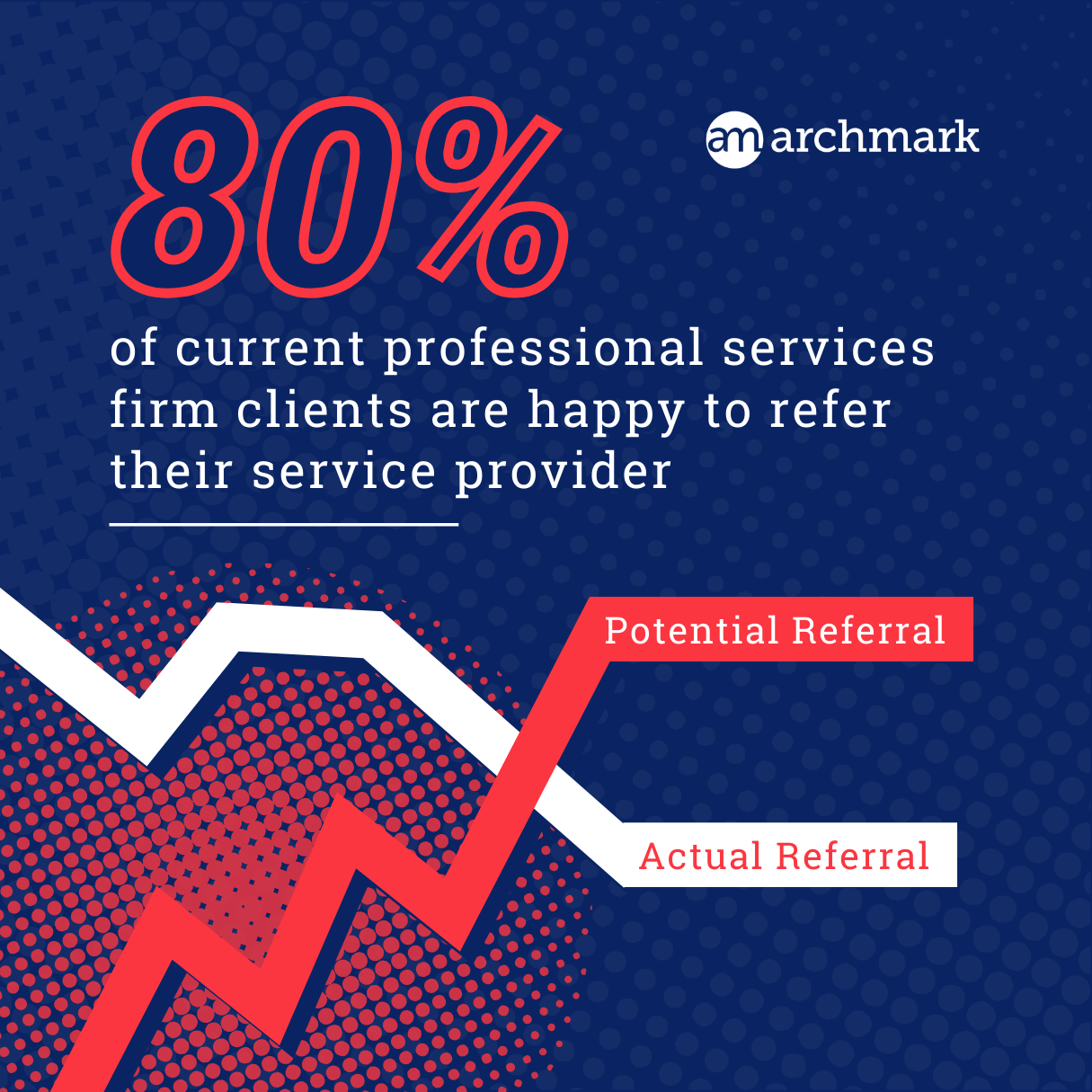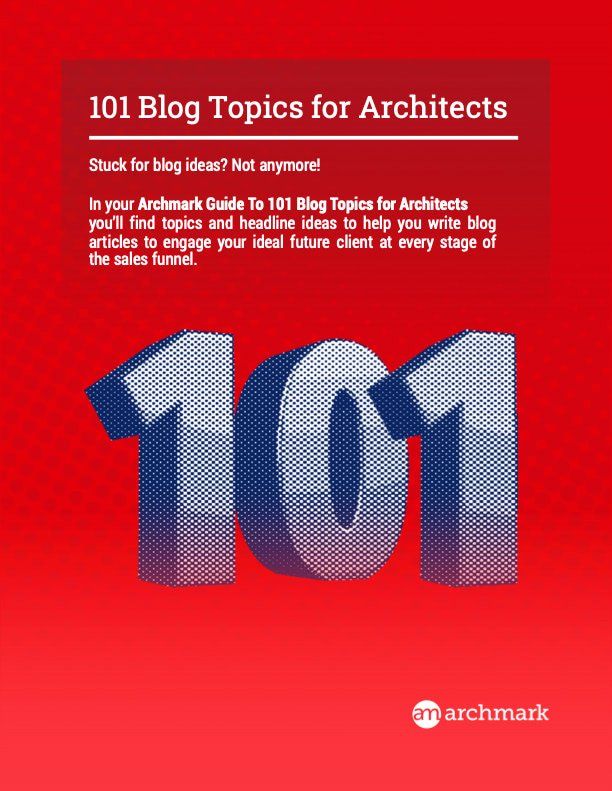Effective Digital Marketing for Architects to Grow Your Firm
It's the 21st Century, You Need to Start Taking Digital Marketing for Architects Seriously!
Architects, can we drop the BS and cut right to the chase. We are now more than 24 years into the 21st Century, if you still believe that digital marketing is not for you, it's time you woke up.
Times have changed, and as someone who has dedicated myself to helping architects, it pains me to see so many of you neglect digital marketing.
The world is online.
Your colleagues, collaborators, and clients are online.
At this point, if you do not have an effective digital strategy for your architecture firm, you are getting left behind.
Now, I realize you may feel that all your clients come from referrals and relationships, and I'm not proposing that you give up on those opportunities; what I am suggesting (actually begging) you to do is to expand and up-level your referrals and relationships using digital marketing for architects.
The Truth About Referrals
Recently, the Hinge Research Institute partnered with the National Association of Certified Valuators (NACVA) and the Exit Planning Exchange (XPX) to conduct an exhaustive online survey of almost 1,200 professional services referral makers. Here is what they found:
- 80 percent of current professional services firm clients are happy to refer their service provider.
- However, only a portion will actually make a referral, and the majority will never find the opportunity.
- Client referrals are limited by the number of clients you have, as well as how many people those clients know who might need your services. Your list of referral makers is finite, and so are the number of referrals they can yield.
- This is especially true for small architecture firms who may work with a few clients per year.
- Focusing solely on client referrals may not produce enough work to grow a sustainable firm.
- Relying on a finite list of clients, colleagues, and collaborators may be limiting your firm's potential to grow.

Add to this the fact that clients who are referred to your architecture firm have many choices in their local markets. They are doing their due diligence by researching you, your employees, and your firm ONLINE.
Yes, that's right! They are scanning your website, Googling your name, looking at your social media posts, reading reviews, and much more.
If you have a weak online presence, they may may make negative assumptions about your firm. At the very least, they are comparing what they find to you competitors to get an impression of your standing in the design industry.
You Need to Get Serious About Digital Marketing Strategies
As an architect, you've likely mastered the art of creating beautiful, sustainable spaces; isn't it time to master how they're seen in cyberspace?
In this article, you'll get a handle on building an unshakable digital marketing strategy that allows you to reach people in a way that builds sustained growth, and provides a good return on your investment.
We're talking about smart search engine optimization (SEO) moves that put your architecture firm on the map, content strategies that flaunt your expertise like never before, and email campaigns that will grow your email list and keep clients coming back for more.
And don't forget about harnessing local search and your online reviews and testimonials—they are worth their weight in trust!
Keep reading to learn how to transform online interest into qualified leads and signed contracts through quality online marketing for architecture firms.
Let’s start shaping your architecture firm's digital marketing strategy today.
Archmark's Blueprint for Effective Digital Marketing for Architects
Gone are the days when an architect's portfolio was bound in leather and showcased in client meeting in posh board rooms.
Today, digital marketing is the main frontier architects ned to focus on to build their reputation and attract clients beyond word-of-mouth referrals.
Unsure where to start?
Here is our 8-step plan to successful digital marketing for architects.
- Create a Website That Gets Found Online & Makes a Great First Impression
- Create Valuable Content That Showcases Your Expertise & Experience
- Using Google's Business Profile for Local Search Results
- Harnessing the Power of Online Reviews
- Create a High Value Digital Download to Build Your Email List
- Use Email Marketing Campaigns to Nurture Inquiries
- Use Social Media to Engage New and Existing Followers
- Online Networking For Collaborative Relationships
Also, be sure to review the most
frequently asked questions about digital marketing for architects.
Create a Website That Gets Found Online and Makes a Great First Impression
Start by Evaluating Your Online Presence With This Quick Exercise
Google your name or your firm's name; each link you see represents an online touchpoint for your firm.
Now, answer these questions:
- How many links related to you or your firm do you count?
- Do those links continue onto the next page, or next several pages?
- Are you impressed with the number of links, or are you disappointed at how few there are?
- Click on a few of the links.
- Is the information you find accurate and consistent from link to link?
- Are these touch points communicating the right messages, are they speaking to your ideal clients?
Now imagine that you are your ideal client. Would you be impressed by your digital footprint? Be honest with yourself.
If your answer is “I don’t know,” “I'm not sure,” “Maybe?,” or “No,” then you can bet your prospective clients are thinking the same or worse, because they aren't giving you the benefit of the doubt.
In fact, the scrutiny is extremely high for architects. Your prospective clients are potentially spending a lot of their money on an architect. In those early stages, they are looking for the best they can get. They may get referrals to your firm and several others. If it comes down to your firm and another, and your web presence is underwhelming, then you may never know you were in the running.
We speak to architects, again and again, who tell us all their clients are referrals, and how they never get inquiries through their website. Many even sound as if they are boasting about this fact.
However, when we look at their profitability, how they spend their time, the caliber of clients they work with and the quality of projects they get, they quickly realize that they missing opportunities because of their online presence.
Having a digital marketing strategy is crucial for any architecture firm, from large to small, and even solo practices.
So what do you need to do to improve your website?
Use Your Architecture Firm Website to make a Great First Impression
Imagine for a moment that your website is the only business development tool you have. It's primary goal is to attract, engage, and convert website visitors from casual browsers into excited and qualified leads who are ready to hire your firm.
How your website looks and what it says about your firm is vital to your success, and will play a huge role in whether or not your potential clients take interest and move to the next step.
If those visitors open your website and it's missing or has outdated information, what kind of impression would that leave. Would they want to stay and explore to learn more or would they leave and never return?
Donald Miller, the author of the bestselling book, Building a Story Brand says, “If you confuse you lose.”
For that potential client, it won't matter who referred them or what they heard about your firm, if your website does not make the right impression, most people will immediately leave. In fact, according to Crazy Egg, most visitors spend an average of 15 seconds on websites.
We have seen architecture firm websites that don't mention that they are architects on their homepage, others that are pages of images without captions or context and barely any useful information about the firm, what they do, who works there, etc.
In order to make a great first impression, your website needs to be easy to navigate, it should give visitors a good overview of your firm’s purpose, what you do best, how you work, and what they can expect from you. It should also have clear calls-to-action guiding visitors towards a high-value download or a paid consultation booking page.
Yes, a clean design with high-quality images will leave a positive impression on prospective clients, but an informative, well-organized site that answers their key questions will win the day..
What to Include on Your Website
Creating an impactful website for your architecture firm is vital for attracting clients and showcasing your experience and expertise. Here’s a streamlined guide to the essential sections your website should feature:
- Home Page: Immediately Capture Attention
Your home page sets the tone for the rest of your website. It should immediately capture attention with high-quality images of your work, a succinct introduction to your firm’s mission, and clear navigation to key sections. Include contact information and calls-to-actions prominently. - About Page: Share Your Story
Detail your firm's history, values, and what sets you apart on the About page. This section is an opportunity to connect personally with potential clients by highlighting your firm's culture and achievements. - Team Bios: Build Personal Connections
Consider featuring team members to personalize your firm. Short bios can showcase the expertise and people behind the projects. If updating this section regularly is challenging, focus on the collective strengths of your firm instead. - Process Page: Explain How You Work
A Process page can demystify your approach for clients, outlining the steps from consultation to project completion. Transparency here builds trust, and including case studies or testimonials can demonstrate your methodology in action. - Services Page: Clarify What You Do
If you don't tell your visitors what you do, they won't be certain that you can help them. Detail the different services you provide and the sectors you serve to help visitors know you are a good fit. - Portfolio: Showcase Your Projects
The Portfolio is where your work shines. Display a variety of projects with detailed images and descriptions, highlighting your creative solutions and the breadth of your experience. - Blog Section: Share Your Expertise
Blog articles are essential to answering your clients key questions. If your articles are properly optimized for Search Engines, they can also be effective in increasing traffic to your website by attracting your ideal clients. - Contact Information:
Ensure Accessibility
Contacting your firm should be effortless. Your contact page should include a form, an email which is connected to a dedicated inbox, your firm's phone number, and your location's address.
Share Informative, High-Value Content
Specifically, content that is of value to your potential clients, and primarily, in the form of blog articles. This is where many firms miss a huge opportunity.
Too many architects focus on creating blog content that is valuable to them, their clients, or other architects. Examples include articles that focus on your firm’s accomplishments and news. We are not saying that your blog can't include this content, but the truth of the matter is that your opinions about the state of the industry, your latest awards, completed projects, magazine appearances, and new hires have marginal value for potential clients. They don't know you or your firm, and that type of content isn’t helpful to them.
Quite simply this content, isn’t going to help you gain leads from your website.
Creating content that answers questions your potential clients have is a great way of providing value while positioning yourself as an expert in the field. This strategy helps build credibility and fosters ongoing engagement with visitors who may return repeatedly for fresh insights, eventually converting into clients.
Optimizing for Search Engines (SEO) to Increase Traffic
To ensure your architecture firm gets found online, it's important to implement Search Engine Optimization (SEO) tactics. SEO is an ongoing set of strategies designed to increase your website's visibility in search engine results.
There are various
guides
available
online which provide detailed information about implementing these strategies, but there are three main components of SEO:
- Technical SEO
- Off-Page SEO
- On-Page SEO
Does your website measure up? Test your website for free with our audit!
Understanding Technical SEO
At its core, Technical SEO involves optimizing your website’s infrastructure so search engines can crawl and index it more effectively.
This doesn't just help improve your site's visibility in search results; it also enhances user experience—a key factor in retaining potential clients who visit your site.
Some key elements of technical SEO are:
- Website Speed: A fast-loading website not only ranks better but also keeps visitors engaged. Tools like Google PageSpeed Insights can help you assess and improve load times.
- Mobile Responsiveness: Making sure the site is easily navigable and accessible on a variety of screen size, like tablets and mobile devices.
- Robot.txt & Sitemap.xml Files: These files are usually created automatically and they provide search engine bots the informatio and rules they need to follow to crawl your site efficiently.
- Site Architecture: Structuring the site in a logical and hierarchical way that is understandable for search engines and users.
- Security: Implementing HTTPS for more secure connections.
- Structured Data: Using schema markup to help search engines understand the context of your content.
- Canonical URLs: Preventing duplicate content issues by specifying preferred versions of similar pages.
Off-Site SEO
Off-site SEO involves efforts made outside of your own website to impact your rankings within search engine results pages.
The main focus of off-site SEO is building the site's reputation and authority by gaining backlinks from other websites. High-quality, relevant backlinks are seen by search engines as votes of confidence in your content, which can improve your site's credibility and search engine rankings.
Off-site SEO includes:
- Link Building: Acquiring high-quality backlinks from reputable sites in your industry.
- Social Media Marketing: Although not a direct ranking factor, social media can increase visibility and traffic to your site, which indirectly benefits SEO.
- Brand Mentions: Both linked and unlinked mentions of your brand can influence its visibility and authority.
- Influencer Marketing: Collaborating with influencers to get your content in front of a larger audience.
- Guest Blogging: Writing articles for other websites to improve reach and backlink profile.
Off-site SEO helps to establish your site's authority and relevance in the broader web ecosystem.
On-Site SEO (On-Page SEO)
On-site SEO, also known as on-page SEO, involves optimizing elements directly on your website to improve its ranking in search engine results pages (SERPs) and attract more website traffic. Unlike off-site SEO, which focuses on external signals like backlinks, on-site SEO is all about the content and structure of your site itself.
Key strategies include:
- Content Quality: Creating high-quality, relevant, and valuable content that meets the needs and interests of your target audience. This includes incorporating targeted keywords naturally and providing comprehensive answers to user queries. We'll go over how to create quality content later in this article.
- Keyword Optimization: Researching and strategically using relevant keywords and phrases within your content, titles, headings, and meta descriptions to improve visibility for those terms in search engines.
- Meta Tags: Crafting compelling title tags and meta descriptions for each page to improve click-through rates from search results. These tags should accurately reflect the content of the pages.
- URL Structure: Utilizing SEO-friendly URL structures that are easy for both users and search engines to understand. Ideally, URLs should include relevant keywords and be structured logically.
- Internal Linking: Implementing a strategic internal linking structure to help search engines crawl the site more effectively and distribute page authority throughout your website.
- Image Optimization: Ensuring all images on the site have descriptive filenames and include alt text to improve accessibility and relevance to related search queries.
- User Experience (UX): Designing a website that is easy to navigate and engaging for users, which can reduce bounce rates and encourage visitors to stay longer on your site.
- Mobile Optimization: Ensuring the site is fully responsive and provides a good user experience on mobile devices, which is crucial as mobile-friendlidness is a ranking factor for search engines.
- Page Speed Optimization: Improving loading times for your website, as faster loading pages provide a better user experience and are favored by search engines.
- Header Tags: Using header tags (H1, H2, H3, etc.) to structure content makes it easier for readers to understand and for search engines to grasp the main topics of your page.
On-site SEO is fundamental for ensuring your website's content is tailored to what search engines deem important and relevant. By focusing on these elements, you can enhance your site's usability, relevance, and authority, leading to better search engine rankings and increased traffic.
Showcase Your Work
A well-designed portfolio section is essential as it allows potential clients to see examples of previous projects you've completed successfully. We recommend including well-written project descriptions that provide insights into your firm's role in the project. It's also important to include testimonials from satisfied customers to provide social proof that enhances trustworthiness in the eyes of new prospects.
Remember, the goal of your website should be to serve as a powerful marketing tool that attracts potential clients and impresses them with your expertise and professionalism.
By implementing these strategies, you'll create an online presence that supports the growth of your architecture firm.
Create Valuable Content That Showcases Your Expertise and Experience.
By creating and sharing valuable content, you can demonstrate your design philosophy, project successes, and industry knowledge.
Architects should focus on blogging, case studies and project descriptions for their content marketing strategy.
Blogging
Blogging is the cornerstone of content marketing for architects. There are two main things to keep in mind when adding to your blog.
- Update it regularly. Find a schedule you can manage and stick with it.
- If your ideal client won't find your content interesting or helpful, don't add it to your blog. When architects don't feel like their blogs are attracting traffic or leads, we find that their blog is full of stuff they, as the architect, find interesting. Save that information for your social media or architecture colleagues.
We recommend a mix of blog posts that help answer questions clients have, showcase you as an expert in your field, and build trust by exposing the back end of what you do.
Not sure what. to write about on your blog,
Download our free guide to 101 architecture firm blogging topics. This helpful guide will get you started with great ideas.
Case Studies
Case studies are invaluable in illustrating your firm's capabilities and the tangible results of your design solutions. They provide a narrative that potential clients can relate to, showcasing challenges, innovative solutions, and outcomes of specific projects.
A well-crafted case study not only demonstrates your expertise but also helps build trust with prospective clients by highlighting successful collaborations and satisfied customers. Including metrics, where possible, such as cost savings, sustainability achievements, or efficiency improvements, will quantify the impact of your work.
Project Descriptions
Detailed project descriptions on your website serve add context to your work, giving potential clients a clear understanding of your capabilities and the breadth of your experience.
Each description should include the project's scope, unique features, materials used, and any particular challenges overcome during the design and construction phases. High-quality photographs and videos can enhance these descriptions, providing a visual complement to the text and allowing visitors to fully appreciate the scale and detail of your projects.
However, finished portfolio images can only tell part of the story. Consider including early sketches from charrette sessions, progress images from site visits, and other images to tell the full story of the project. Where did you find your inspirations, what materials did you use, how did you solve structural challenges.
It's also important to select images carefully. Too many firms do ‘image dumps’ in their portfolios, where they. seemingly include every image taken of the final project. Be selective in choosing images. Take a look at how magazines select images. Choose only the very best images, and select them to create a sequence that takes you through the project and supports the narrative of your project descriptions.
Don’t Forget Other Types of Content
There are other types of content that can also give your firm a boost, like video content and podcasts..
Videos are a fantastic way to tell your project's story. Who doesn’t love watching ideas come to life? Especially when narrated by a architect who has taken the project from concept to reality.
Drone footage or virtual tours allow web visitors to experience your work without having to be there.
Guesting on podcasts that reach your potential clients or other professionals can help you connect with new audiences and networks.
Get creative with how you put out content. Create the type of content that works best for you and that you will be able to maintain regularly.
Creating Good Content
The foundation of effective content marketing lies in creating content that is engaging, informative, and tailored to your target audience.
Here are some tips for creating good content:
- Understand Your Audience: Know who you are writing for, whether it's potential clients, students, or peers in the architecture industry. This understanding will guide the tone, complexity, and topics of your content.
- Be Authentic: Share your unique perspective and voice. Authenticity resonates with readers and helps build a loyal following - not to mention it significantly enhances your brand awareness.
- Focus on Quality: Prioritize the quality of your content over quantity. Well-researched, thoughtfully composed content is more likely to engage readers and encourage shares and backlinks.
- Use Visuals: Architecture is a visual art, and incorporating diagrams, sketches, renderings, and photographs can significantly enhance the appeal and comprehensibility of your content.
- Optimize for SEO: Use relevant keywords naturally, structure your content for readability (with headers and bullet points), and ensure your website is mobile-friendly to improve your content's visibility on search engines.
Content marketing for architects is not just about showcasing your work; it's about engaging your audience in a meaningful way, providing value, and building relationships.

Using Google’s Business Profile for Local Search Results.
For architecture firms wanting to improve their visibility for online searches in the geographic areas they serve, Google's Business Profile (GBP) is a digital Swiss Army knife.
Your Online Storefront
GBP is Google's virtual version of Main Street USA. It is a free tool that allows you to control what information is shown when your firm appears in Google Search and Maps. Your Business Profile makes it easier for clients to get information and connect with your firm, without leaving Google Search or Maps. GBP also allows you to post firm updates, list your services, share photos, and more.
When your profile is properly optimized, your firm is more likely to appear to those people searching for your services in your geographic area.
Optimizing your GBP profile starts with claiming your listing. Once claimed, you need to make sure that your business name, address, and phone number are accurate. If these details aren't spot-on, clients might end up at a coffee shop down the street instead of marveling at your concept sketches.
Your Business Profile also allows you to request reviews from current and past clients. Reviews are very helpful in ensuring that your firm appears in search listings, as they add credibility.
Moving beyond basics, your Business Profile is a great place to post photos. Upload crisp images of completed projects or ongoing work that showcases not just architecture but also narrative storytelling. And don't forget to showcase your team members to put a human face to what you do and give prospective clients a glimpse into your firm's culture and
Picking Precise Categories for Your Google Business Profile
GBP also allows you to select specific categories for your firm. Selecting these categories is important in helping Google understand your business. Unfortunately, in the past, the categories related to architecture and design were very limited. Recently, Google has expanded the choices available to firms, including:
- Architect
- Architecture Firm
- Architectural Designer
- Building design company
- Building designer
- Design Engineer
- Interior Architect Office
- Interior Designer
- Landscape Architect
Selecting categories should be precise. You can pick more than one category, but be sure you are using categories that describe what you/your firm does best (‘Architecture Firm’’ versus ‘Interior Architect Office’).
Doing so tells Google how to place you in searches which means getting found by those who need yourd skills.
Creating Effective Service Descriptions
For each category you select, you can also create a list of services. This provides Google, and online searchers, more detail about your firm and the services you offer.
However, adding services and descriptions is an art in and of itself.
On one hand, these descriptions help prospective clients better understand your firm and why they should choose YOU among all others out there. On the other hand, stratergically placed keywords in your service descriptions helps Google map your firm to more search results. This doesn't mean you shoudl try to game the system. It's always better to be accurate and concise.
An FAQ That Works While You Sleep
Another great feature of Google Business Profile is the FAQ section. This is somewhat hard to find, as it is hidden in the Chat section of GBP, which you first need to turn on. Once activated, you can add a customized FAQ to the chat tool to recommend questions and answers to common queries you receive for clients. Admittedly, most people do not interact with this tool, but this is another way you can help Google understand your business.
Harnessing the Power of Online Reviews
A whopping 92% of consumers read online reviews before making a purchase decision.
This statistic isn't just impressive; it's an outright call to action for architects looking to bolster their digital marketing efforts. By encouraging satisfied clients to share their positive experiences with your firm, you're amplifying word-of-mouth in its most potent form—the internet.
But don’t just take our word for it; according to BrightLocal’s Local Consumer Review Survey, 50% of those surveyed said that they trust reviews as much as personal recommendations from friends and family.

The Art of Asking for Reviews
To get those five-star ratings rolling in, timing is everything. Reach out when your client's joy over that stunning new building design is still fresh—but also give them enough time post-occupancy so they can truly appreciate living or working within the sapce you designed for them.
Be specific in what you ask: “Could you mention how we tackled project challenges?” Tailoring requests like this helps potential clients see exactly where your strengths lie without having been part of any prior projects themselves.
Also, make it easy for clients. Give them direct links or set up an automated email after project completion asking if they’d be willing to leave feedback. If possible, schedule a "project feedback call" on Zoom so you can record what they say, and use their direct comments.
Want to dig deeper into the task of asking for reviews? Download our free guide, How to ask for Recommendations and Reviews.
Showcasing Stellar Service with Testimonials
It's tempting to want to create a dedicated space where these golden nuggets will live. But we caution you against creating a testimonial page on your website. Based on the analytics reports we have seen on the past sites of many of our clients, these pages rarely get seen by visitors.
Instead, spread the wealth by placing them in high traffic areas like your homepage, about page, service page, and in the project descriptions of their respective portfolio pages.
When selecting which quotes to include on your website, keep in mind that authenticity is what matters most with prospective clients. Select testimonials based on what is said, not who the client is. Also try to avoid using testimonials that read like they were asked to say nice things. Instead, ask them specific questions that illicit their actual experiences and the joy they received from the project.
For larger firms, including diverse voices—from small residential clients to corporate executives of large firms—can paint a complete picture of versatility and adaptability while illustrating successful collaborations across various scales and styles which speaks volumes more than self-promotion ever could.
Create a High Value Download to Build Your Email List
Architects have a unique opportunity to leverage online platforms to generate leads and build relationships with prospective clients.
A highly effective strategy, which is often overlooked by architects, is creating a lead magnet, sometimes known as a 'monkey's fist,' 'tripwire offer,' or most simply, a downloadable PDF. The goal of a lead magnet is to exchange value (in the form of an ebook, checklist, project planner, or other resource that will help your ideal clients) for your website visitor's name and email, so you can continue to provide them value by adding them to your email list.
When done right, your lead magnet, and the drip emails that follow it, will serve to build trust and rapport with your prospects over the time of the campaign. This also keeps your firm top of mind with these subscribers, so that, when they are ready to move forward with their project, they remember to contact your firm.
How Can A Lead Magnet Deliver Value to Prospective Clients?
The first step in creating a compelling lead magnet is understanding what your ideal client needs most, prior to hiring an architect?
- Are they looking for ideas and inspiration?
- Do they need guidance about hiring an architect?
- Are they asking about sustainable design?
- Are they trying to navigate permitting?
By identifying these needs, you can tailor content that resonates deeply with them. If you are unsure, consider conducting surveys or analyzing frequently asked questions on forums like Houzz to gather insights.
Select the Right Format
Once you understand what information will be most valuable to your target audience, it’s time to decide on the format of your digital download. Options include eBooks, whitepapers, checklists, or even interactive tools such as cost calculators specific to architectural projects.
The key is choosing a format that aligns with both the complexity of the information you're sharing and how your audience prefers to consume content.
- eBooks: Great for comprehensive guides or showcasing project portfolios.
- Whitepapers: Ideal for more technical discussions or research findings.
- Checklists: Perfect for actionable tips and steps related e.g., preparing for an architectural project.
- Interactive Tools: Engage users by providing personalized results or recommendations based on their inputs.
Promote Your Download Effectively
Crafting an invaluable resource is just one part of the equation; promoting it effectively ensures it reaches its intended audience. Utilize social media channels where potential clients are active—LinkedIn might be particularly useful given its professional focus.
Include the download as a link in some of your most popular blog posts. Share the download with your current email list and ask them to share the email with family or friends, if they like the download.
Consistency across all channels will amplify your message. Make sure to share your resource often and as much as you can to reach your prospective clients.
And don't be scared of oversharing. Your average follower or reader isn't going to see every single thing you share on social media or in your emails. And according to David Olgilvy, the famous advertising expert, most people need to see your offer several time before they will take action to download it.
Use Email Marketing Campaigns to Nurture Inquiries
Now that you have a strategy to build an email list, it's time to turn that list into clients using email marketing. Now, this isn't just about blasting newsletters and hoping someone bites; we're talking about crafting targeted drip campaigns that resonate with the right audiences—your future clients.
Personalizing Your Message
To stand out in an inbox full of offers, you've got to get personal. An inbox can be a great place to have intimate, open, and honest conversations with clients that showcase you and your firm's personality, while building rapport and trust with prospective clients.
But the key to personalization is organizing your email contacts into segmented lists, based on their current interests or past engagements. Segmenting is important because it allows you to tailor your email content to the specific needs of different audinces Instead of sending generic messages on blast to every person in your email management tool, you can send emails that make clients feel like you truly understand their precise situation and need. this is an important part of establishing trust..
A number of surveys have shown that, when emails are personalized, they create much higher engagement and interest. Use can use your expertise and your understanding of your ideal client's needs to create emails that make your subscribers feel like you are in their heads, like your fully understand them.
Turning Leads and Prospects Into Clients With Valuable Content
Drip-feeding potential clients with additional nuggets of wisdom over time helps to them better understand your architectural capabilities, expertise, and talents. It also builds anticipation for them, the more they hear from your the more they are getting excited about the potential of working with you.
A crucial factor here is sharing the right content. By addressing the issues they may be dealing with at the early stages, you are addressing they things they are facing in that moment. This can hold incredible value for prospective clients and it can build their trust to a point where, when they finally do meet, the are ready to hire you.
But be sure to analyze your campaigns and make necessary adjustments as you go. Check your open rates and click-throughs to see what topics bring readers in for consultations. Tools such as Constant Contact, Mailchimp, or our preferred email list and CRM tool, ActiveCampaign, can provide helpful insights.
Should You Send an Email Newsletter?
Sending out updates about your firm is something we do not recommend for every client. The honest truth is that a traditional newsletter that keeps clients up-to-date about your firm's latest completed projects, awards, and new hires is not of great interest or value.
However, involving your team members by including personal notes from them, or asking them to share parts of their lives outside work can be very effective. Of course, this will depend on the culture of your firm, but adding warmth and authenticity to your newsletter can turn the coldest leads into warm prospects.
It's all about creating conversations and keeping them going to build and maintain relationships. But keep in mind, you can't force authenticity, you can't create warmth without fuel. If you feel you can't do something genuine and engaging with your email newsletter, then our best advice is to stick to drip campaigns.
Cultivating an engaged following on social media might seem daunting but think about it this way—it’s just another form of community building.
Platforms such as Instagram provide great opprotunities for visual storytelling where each post contributes towards constructing an ever-growing narrative around your firm's brand identity.
But don't forget LinkedIn; it’s been shown that professionals trust information shared on the platform three times more than other social channels—a statistic worth noting when considering how to grow your connections.

Showcase Your Work Visually
Architects have the advantage of working in a highly visual profession. Use this to your advantage by posting high-quality images and videos of your projects, early design concepts, and construction progress. Instagram and Pinterest, in particular, are perfect platforms for visual storytelling, allowing you to create appealing portfolios that speak to your target audience.
Engage with Your Community
Social media isn't just a broadcasting channel; it's a two-way street. Engage with your followers by responding to comments, participating in discussions, and even sharing user-generated content related to your projects. This engagement helps build a community around your brand, fostering loyalty and increasing the likelihood of word-of-mouth referrals.
Build Brand Awareness
Consistent, engaging social media content increases your firm's visibility and helps build your brand awareness. Use social media platforms to convey your firm’s values, mission, and the unique approach you bring to your profession. Use social media to differentiate your firm in a crowded market and attract clients who share your values.
Utilize Paid Advertising
While we found that paid social media advertising can have limited value for architects. Platforms like Facebook and LinkedIn offer targeted advertising options that can significantly increase your reach to specific demographics, such as potential clients in your local area or those interested in sustainable design. These targeted ads can be an efficient way to increase your visibility and build awareness with specific demographics. For example, when trying to attract new hires, or when trying to increase public sentiment for a major project.
Monitor and Adapt
Social media trends and algorithms evolve constantly. Stay on top of these changes by regularly reviewing your analytics to understand what content performs best and why. Use these insights to refine your strategy, experiment with different types of content, and optimize your posting schedule for maximum engagement. And a final word of advice, you do not have to be on every channel. In fact, it is much more effective to build your presence one channel at a time. Too many spinning plates tend to crash easily.
Online Networking For Collaborative Relationships
Today, digital platforms have transformed how professionals connect, collaborate, and secure new opportunities. Think of LinkedIn as a virtual mixer where handshakes are replaced with connection requests.
Architects who harness these online tools can tap into a wellspring of potential clients and collaborators far beyond their geographic limits. With more than one billion users on LinkedIn, a random, single connection could lead to your next big project.
Check out our free download with a checklist to optimize your LinkedIn profile!
But simply being present online isn't enough; you've got to engage actively. Joining groups dedicated to architectural design sparks conversations that showcase your expertise while building relationships with peers across the globe. Sharing insights or commenting on discussions might just catch the eye of someone looking for exactly what you bring to the table.
The Art of Digital Networking
Digital networking is an art form in itself – think less about selling yourself aggressively and more about cultivating genuine connections through shared interests and thoughtful dialogue.
The trick lies in offering help or value before asking for anything in return; this establishes credibility within your community which can be critical when someone needs architectural services down the line.
To really stand out, consider creating content that resonates with both industry insiders and prospective clients alike:
Informative articles, engaging visuals showcasing past projects, or insightful commentary on trends can elevate your profile from mere background noise to thought leader status.

Finding Your Tribe Online
Finding communities online may feel daunting at first glance but fear not - there's likely already a niche carved out ready for you join.
For architects specifically seeking sustainable solutions or high-tech integrations into their designs—there are corners within networking sites tailored just for those interests.
Becoming active members within these specialized forums offers invaluable insight from others who share similar challenges—and victories—in architecture today whilst also positioning yourself firmly amongst those shaping tomorrow's built environment landscape directly through innovative discussion threads or collaborative initiatives birthed right from these very interactions.
FAQ - Frequently Asked Questions About Digital Marketing for Architecture Firms
What is digital marketing for architecture firms?
Digital marketing for architecture firms involves strategies to promote your architectual services and brand online. It includes building a professional website, optimizing that site for search engines (SEO), using email marketing to reach potential clients, and engaging followers and fans on social media, . The goal is to enhance online presence, showcase work, and engage with clients effectively.
Why is digital marketing important for architects?
Digital marketing is crucial for architects because it helps increase visibility, attract potential clients, engage with a broader audience, and build a strong brand presence online. It allows firms to showcase their projects, share their expertise, and establish thought leadership in the architecture industry.
What are the key components of a digital marketing strategy for architects?
The key components include a professional website, search engine optimization (SEO), content marketing, social media engagement, lead generation, and email marketing. Each element plays a vital role in creating a comprehensive digital presence that attracts and retains clients.
How can architects optimize their website for better visibility?
Architects can optimize their website by ensuring it is mobile-friendly, loading quickly, featuring high-quality images of their projects, including relevant keywords for SEO, and regularly updating the site with fresh content like blog posts and project updates.
What role does content marketing play in an architect's digital marketing strategy?
Content marketing allows architects to showcase their expertise and projects through various formats like blogs, e-books, white papers, videos, and podcasts. This helps in building brand authority, engaging the audience with valuable information, and improving search engine rankings through keyword-rich content.
Which social media platforms are most effective for architects?
Visual platforms like Instagram and Pinterest are particularly effective for architects due to their focus on imagery. LinkedIn is also beneficial for networking and B2B opportunities, while Facebook and Twitter can help in community engagement and sharing updates.
What common mistakes should architects avoid in digital marketing?
Common mistakes include neglecting website SEO, underestimating the power of social media engagement, not utilizing email marketing effectively, ignoring the importance of high-quality content, and failing to analyze and adjust strategies based on performance metrics.
Can small architecture firms compete with larger firms in digital marketing?
Yes, small firms can compete effectively by focusing on niche markets, leveraging the power of local SEO, creating high-quality, targeted content, and engaging with their community on social media. Personalized marketing and the unique value proposition of smaller firms can stand out in the digital space.
Where can architects find more resources on digital marketing?
Architects can explore Archmark's blog articles to get started. We also offer several other resources to help you. You can also look for indfustry webinars, online courses, and digital marketing books. Networking with peers and consulting with digital marketing professionals specializing in the architecture industry (like Archmark) can also provide valuable insights and guidance.
What Does the Future Hold for Your Architectural Firm Online?

Navigating the digital marketing is crucial for architects looking to sustain or grow their firms. In fact, we will argue that digital marketing for architects is no longer optional; it's essential for growing your visibility, finding new clients, and gaining financial stability. By embracing strategies from SEO to social media, architects can expand their reach and solidify their online presence.
This guide has offered a roadmap for harnessing digital marketing's power to elevate your architecture firm. Implementing these strategies will not only showcase your unique talents but also connect you with those who need them most.
If you are ready to forward with a digital marketing strategy to ensure your firm's online presence is as innovative and impactful as your designs, this is your invitation to apply for a free 20-minute clarity call today.















Use Social Media to Engage New and Existing Followers